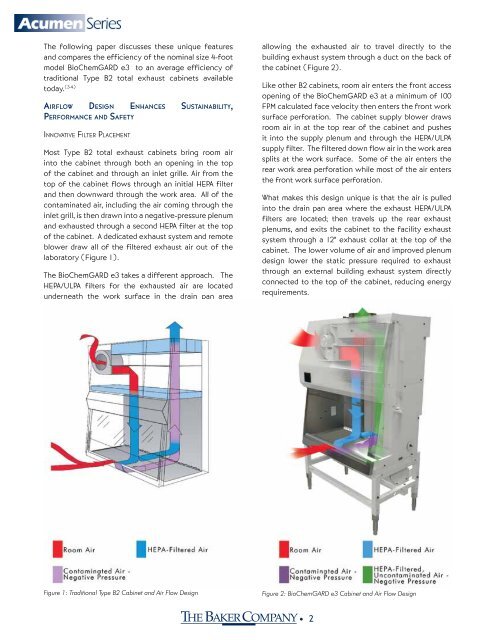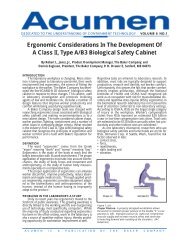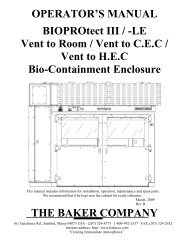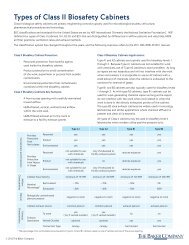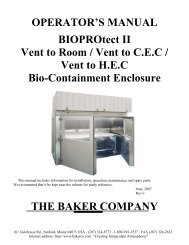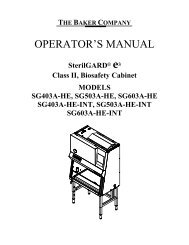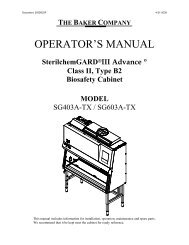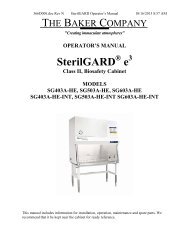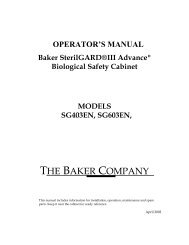Download the BioChemGARD white paper - The Baker Company Blog
Download the BioChemGARD white paper - The Baker Company Blog
Download the BioChemGARD white paper - The Baker Company Blog
You also want an ePaper? Increase the reach of your titles
YUMPU automatically turns print PDFs into web optimized ePapers that Google loves.
<strong>The</strong> following <strong>paper</strong> discusses <strong>the</strong>se unique features<br />
and compares <strong>the</strong> efficiency of <strong>the</strong> nominal size 4-foot<br />
model <strong>BioChemGARD</strong> e3 to an average efficiency of<br />
traditional Type B2 total exhaust cabinets available<br />
today. (3-4)<br />
Airflow Design Enhances Sustainability,<br />
Performance and Safety<br />
Innovative Filter Placement<br />
Most Type B2 total exhaust cabinets bring room air<br />
into <strong>the</strong> cabinet through both an opening in <strong>the</strong> top<br />
of <strong>the</strong> cabinet and through an inlet grille. Air from <strong>the</strong><br />
top of <strong>the</strong> cabinet flows through an initial HEPA filter<br />
and <strong>the</strong>n downward through <strong>the</strong> work area. All of <strong>the</strong><br />
contaminated air, including <strong>the</strong> air coming through <strong>the</strong><br />
inlet grill, is <strong>the</strong>n drawn into a negative-pressure plenum<br />
and exhausted through a second HEPA filter at <strong>the</strong> top<br />
of <strong>the</strong> cabinet. A dedicated exhaust system and remote<br />
blower draw all of <strong>the</strong> filtered exhaust air out of <strong>the</strong><br />
laboratory (Figure 1).<br />
<strong>The</strong> <strong>BioChemGARD</strong> e3 takes a different approach. <strong>The</strong><br />
HEPA/ULPA filters for <strong>the</strong> exhausted air are located<br />
underneath <strong>the</strong> work surface in <strong>the</strong> drain pan area<br />
allowing <strong>the</strong> exhausted air to travel directly to <strong>the</strong><br />
building exhaust system through a duct on <strong>the</strong> back of<br />
<strong>the</strong> cabinet (Figure 2).<br />
Like o<strong>the</strong>r B2 cabinets, room air enters <strong>the</strong> front access<br />
opening of <strong>the</strong> <strong>BioChemGARD</strong> e3 at a minimum of 100<br />
FPM calculated face velocity <strong>the</strong>n enters <strong>the</strong> front work<br />
surface perforation. <strong>The</strong> cabinet supply blower draws<br />
room air in at <strong>the</strong> top rear of <strong>the</strong> cabinet and pushes<br />
it into <strong>the</strong> supply plenum and through <strong>the</strong> HEPA/ULPA<br />
supply filter. <strong>The</strong> filtered down flow air in <strong>the</strong> work area<br />
splits at <strong>the</strong> work surface. Some of <strong>the</strong> air enters <strong>the</strong><br />
rear work area perforation while most of <strong>the</strong> air enters<br />
<strong>the</strong> front work surface perforation.<br />
What makes this design unique is that <strong>the</strong> air is pulled<br />
into <strong>the</strong> drain pan area where <strong>the</strong> exhaust HEPA/ULPA<br />
filters are located; <strong>the</strong>n travels up <strong>the</strong> rear exhaust<br />
plenums, and exits <strong>the</strong> cabinet to <strong>the</strong> facility exhaust<br />
system through a 12” exhaust collar at <strong>the</strong> top of <strong>the</strong><br />
cabinet. <strong>The</strong> lower volume of air and improved plenum<br />
design lower <strong>the</strong> static pressure required to exhaust<br />
through an external building exhaust system directly<br />
connected to <strong>the</strong> top of <strong>the</strong> cabinet, reducing energy<br />
requirements.<br />
Figure 1: Traditional Type B2 Cabinet and Air Flow Design<br />
Figure 2: <strong>BioChemGARD</strong> e3 Cabinet and Air Flow Design<br />
• 2


